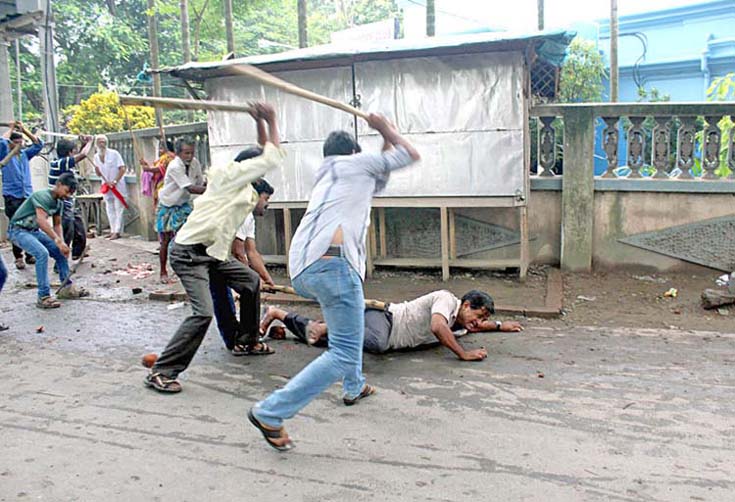
Debasish Chakraborty in Kolkata
SIGNS are evident enough; West Bengal is in resistance mood.
Four and a half year after the change of government, the bitter experiences of the people are now getting crystallised. The all-out attack on opposition voices has spread to wider sections of the people. The state is ruled by the ruffians of the ruling party, from the grassroots level to the top. Economic condition of the state has gone from bad to worse with a completely rudderless government. Anarchy has become the rule of the day in education. Sufferings of the people are getting intensified day by day.
Till date, every attempt of protest and dissent has been suppressed either by physical attacks by the ruling party hoodlums or by a notoriously politicised police force. Thousands have been framed in false cases.
Signs are evident enough; the fear psychosis, the foundation of Mamata Banerjee’s rule is now giving way to desperate resistance.
And, quite naturally the Left parties and Left forces are leading the intensified protest actions. Two major protest actions have taken place in a span of seven days.
On August 27, tens of thousands of people, mostly peasants, agricultural workers and rural toiling masses, marched towards Nabanna, the state administrative headquarters and chief minister’s office. They came at the call of the Left peasants and agricultural workers’ organisations. Mass organisations of other sections and Left parties supported the call. Despite a large part of the state still suffering from flood, human waves virtually blocked all roads to Nabanna for the first time. People came in trains, buses, walking long distances and marched towards Nabanna from four points - two in Kolkata and two in Howrah. Police resorted to heavy lathicharge, tear gassing and used water cannons. Hundreds have been injured. Despite this brutal attack, more than two thousand volunteers reached the main door of Nabanna. They were mercilessly beaten up and tear gas was used to disperse the rally. Nearly 500 people sustained injuries of various kinds. The chief minister has threatened the entire Left movement with dire consequences and even claimed that she could ‘finish off in one minute’ the entire Left force.
TOTAL
GENERAL STRIKE
The next battle started immediately after. While trade unions and Left parties geared up their campaign for the General Strike, the state administration exerted all energies to foil it. Circulars were issued that government employees would face stringent punishment if they fail to attend office on September 2. State administration kept no stone unturned to thwart the strike. TMC gangs attacked campaign rallies in many places.
But, on September 2, the state witnessed most widespread, spontaneous, successful General Strike in the recent memory. Braving terror and attack by the TMC and the state administration, people participated in a total shut down in the state, much beyond the scope of an industrial action. Industries, shops and establishments, educational institutions remained closed. Kolkata streets were deserted. State government has forced state roadways buses to ply though in much less numbers than usual, with very few passengers, even empty vehicles. Transport in private sector and in districts have been hit hard. Power generation has declined in Kolkata and districts by upto 30 percent. 202 tea gardens were closed in three districts in northern Bengal out of 210. Jute mills, coal mines, port were closed.
Trade Union activists and workers of 17 Left parties were in the streets in thousands. Road and rail blockade was organised throughout the state. Rallies, processions, street squads were seen everywhere. In Kolkata, leaders of 17 Left parties including Biman Basu, Suryakanta Misra marched in a rally. It was the most memorable intervention by the Left forces in recent history.
TMC and police combined to attack strikers in many places. In Baharampur in Murshidabad district, TMC brought anti-socials and attacked the CPI(M) district committee office. They had mercilessly beaten the CPI(M) workers and instead of protecting them, the police attacked Party workers. At least 10 CPI(M) activists including former MP Moinul Hassan have been seriously injured.
In Hariharpara in Murshidabad, CPI(M) office was attacked and many Party leaders suffered injuries. CPI(M) MLA Insar Ali had to be hospitalised.
In Siliguri, police attacked to clear road blockade and arrested CPI(M) leaders including Mayor Ashok Bhattacharya, CPI(M) district secretary Jibesh Sarkar and others.
In Birbhum, armed gangs attacked strikers in Sainthia, Mahammad Bajar.
Strikers were attacked in various places in North 24 Parganas, West Midnapore and Burdwan. In Aushgram in Burdwan, one CPI(M) activist has suffered bullet injury.
In Jalpaiguri, tea garden worker unitedly clashed with police in a tea garden. CPI(M) and trade union leaders were arrested.
However, the mood of resistance among the people was so resolute that TMC activists were not even visible in many areas. 17 Left parties called statewide protest rallies on September 3, condemning attacks on strikers.
Signs are evident enough that the resistance will only grow.


